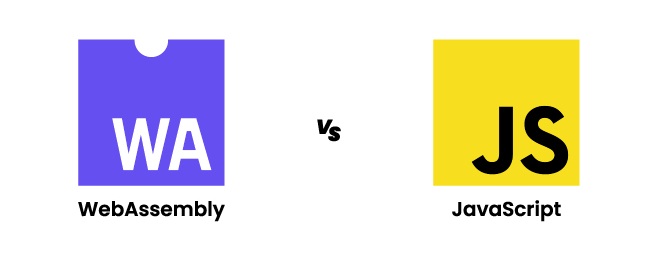Which one to choose: WebAssembly or JavaScript?
Published on

Introduction
JavaScript has been the bedrock of client-side web development since the mid-1990s. It is deeply integrated into browsers, making it the default language for building interactive web applications. However, in recent years, WebAssembly (WASM) emerged as a low-level bytecode that can run in the browser at near-native speeds. As more developers look beyond JavaScript alone, it's helpful to understand when WebAssembly is advantageous and when it isn't.
JavaScript
JavaScript pros
-
Universal browser support
Every major browser ships with a built-in JavaScript engine, which means JavaScript code runs anywhere without additional installation. As a result, JavaScript enjoys one of the largest and most consistent “run everywhere” footprints of any language.
-
Rich ecosystem
JavaScript has the world's largest package ecosystem (NPM). This includes frameworks (React, Angular, Vue, Svelte), libraries, and tooling that can simplify most aspects of web development.
-
Dynamic and flexible
JavaScript is dynamically typed, which speeds up development in many cases. Developers can write code quickly without rigid type constraints. The flexibility also makes rapid prototyping convenient.
-
First-class in browsers
The browser environment deeply integrates with JavaScript (DOM APIs, event model, CSS manipulations, etc.). Developers have direct access to all browser APIs and can manipulate webpages interactively with minimal setup.
JavaScript cons
-
Performance limitations
While JavaScript has become dramatically faster in modern engines (V8, SpiderMonkey, Chakra, JavaScriptCore), it is still a higher-level, dynamic language. It can be significantly slower than compiled languages, especially for CPU-intensive tasks.
-
Dynamic typing complexities
Dynamically typed code can become difficult to maintain as applications grow large, leading to runtime type errors. Tools like TypeScript mitigate this, but the core language itself can be a source of bugs if used carelessly.
WebAssembly
What is WebAssembly?
WebAssembly (often shortened to WASM) is a low-level, binary instruction format designed to run at near-native performance in browsers (and other environments). You typically write code in C, C++, Rust, or other supported languages, and compile it to .wasm bytecode. This bytecode then runs in a virtual machine integrated into browsers.
WebAssembly pros
-
High performance
WebAssembly code often outperforms equivalent JavaScript (especially for CPU-intensive tasks such as image processing, 3D rendering, scientific simulations, etc.). It achieves near-native speeds due to its low-level, ahead-of-time compiled approach. It runs almost at the native speed.
-
Language flexibility
Languages like C, C++, Rust, Go, and more can compile to Wasm, allowing developers to leverage existing codebases and libraries. This is especially useful for bringing legacy or performance-critical code to the web.
-
Security sandbox
WebAssembly modules run inside a memory-safe, sandboxed environment. There's no direct memory access outside the module's assigned range, which helps prevent common vulnerabilities like buffer overflows.
WebAssembly cons
-
High performance is not guaranteed
Unfortunately WebAssembly doesn't always outperform JavaScript. This is can happen when it's used as a largely dynamically typed language, such as JavaScript itself. JavaScript by itself is extremely optimized for its purpose, and it's implemented natively.
-
Limited direct access to browser APIs
While there are ways to interface WebAssembly with JavaScript, you can't (yet) directly manipulate the DOM purely from a Wasm module. Most interactions—like event handling or DOM updates—are mediated through JavaScript bindings.
-
Complex build tooling
Building for Wasm often involves compiler toolchains and lower-level languages. This can feel more complicated than writing a straightforward JavaScript file, especially if you're new to compiled languages or C/C++ build systems.
-
Binary format & debugging complexity
While browser dev tools have begun supporting Wasm debugging, it's still more cumbersome than working directly with source-mapped JavaScript. Viewing or stepping through optimized Wasm bytecode requires specialized debugging techniques.
-
Overhead for small scripts
For small pieces of logic, Wasm may not bring a performance advantage substantial enough to justify the extra complexity. The cost of loading the Wasm module and bridging to JavaScript can outweigh small gains.
Choosing between JavaScript and WebAssembly
-
Purely web-focused, lightweight interactions
Use JavaScript. If your workload is typical DOM manipulation, interactive UI, and network calls, JavaScript's ecosystem and direct DOM access are ideal.
-
Performance-critical or resource-intensive tasks
Use WebAssembly. For CPU-intensive algorithms (e.g., image editing, real-time audio processing, data compression, cryptography, 3D rendering), compiling to Wasm can result in major performance gains.
-
Interoperability with existing native code
Use WebAssembly. If you have a large C/C++ or Rust codebase that you want to port to the web, Wasm can let you reuse that code with minimal rewriting.
-
Rapid development & prototyping
Use JavaScript. For fast iteration, broad community support, and minimal tooling friction, JavaScript is a simpler choice.
Conclusion
JavaScript remains the de facto standard for web development due to its universal support and rich ecosystem. WebAssembly complements JavaScript by enabling near-native performance for CPU-heavy tasks, along with the ability to bring code from compiled languages into the browser.
- If your application relies on typical web interactions, JavaScript's direct DOM integration and myriad libraries usually make it your best choice.
- If you need performance comparable to native code, or want to reuse large existing codebases from C/C++/Rust, WebAssembly opens the door to powerful, optimized web applications.
In the future, we can expect WebAssembly tooling and its integration with browser APIs to continue maturing—further bridging the gap between low-level power and everyday web development.